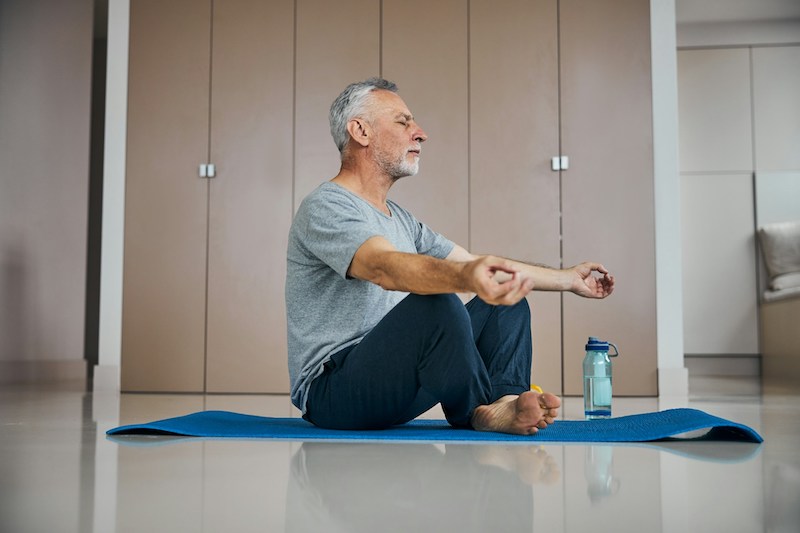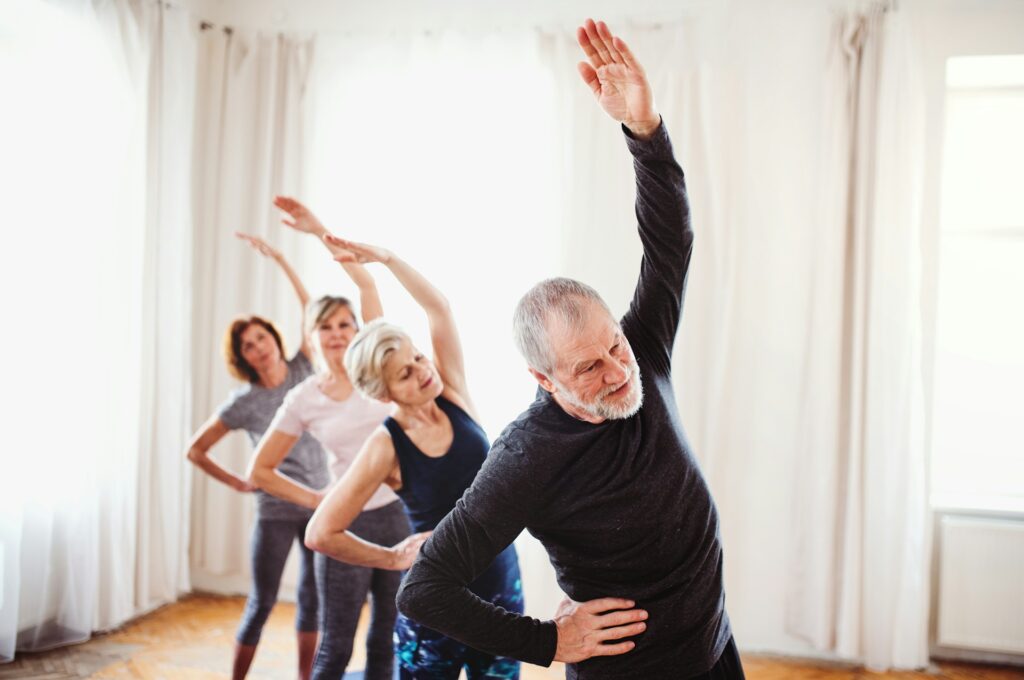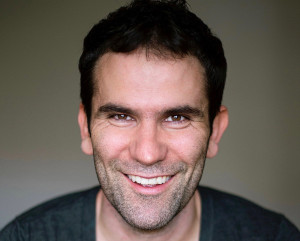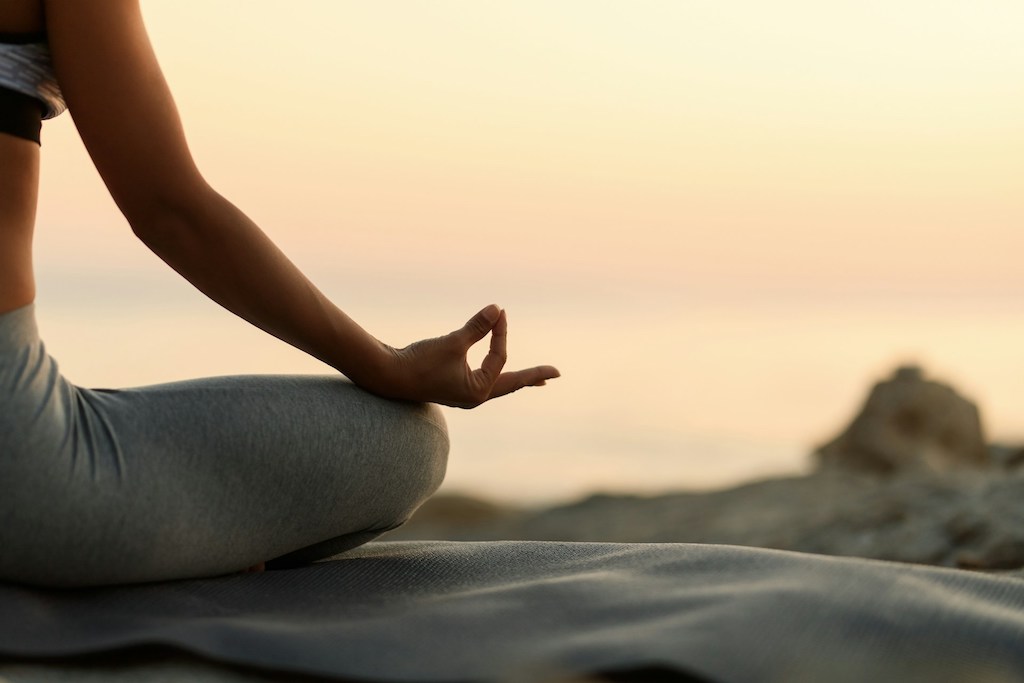When we’re in pain, we usually try to escape it at all costs. But focusing our attention on the present moment, also known as practicing mindfulness, may actually help to alleviate pain and other symptoms of rheumatoid arthritis.
Pain is often made worse by our relationship to it. We all know the more we focus on something, the more it seems to amplify.
Mindfulness and meditation help relieve the anxiety and stress around joint pain and arthritis symptoms, helping us to experience more ease.
What is mindfulness?

You’ve likely heard about mindfulness and its benefits. But what exactly is it?
Mindfulness means paying full attention to the present moment, to what is happening around you and within you, without judgement.
While the roots of mindfulness come from ancient eastern traditions like Buddhism, the practice was developed further into mindfulness-based therapies by Dr Jon Kabat-Zinn in the 1970s. These practices help people develop a stronger awareness of what is happening in the mind and body.
When we’re mindful, we become the kind observer of our thoughts, feelings and bodily sensations. We let everything flow in and out.
Mindfulness doesn’t mean making our pain disappear or willing the bad stuff away. It’s about acceptance and changing our relationship to it.
Oftentimes, with chronic conditions and pain, our nervous systems get stuck in an endless feedback loop, which worsens our perception of what we’re dealing with.
Meditation and practices such as body scans, mindful movement, and breathwork work to calm and regulate the nervous system, relieve stress, and make pain feel less intense.
The benefits of mindfulness and meditation

Many of us live our lives in stress mode, more than we’d like to admit. Pain and stress interact on multiple levels in a vicious cycle that seems impossible to intersect. Stress not only causes inflammation but can “heighten the perception of pain” (Landau, M.D, 2023)
So, what do we do about it?
Of course, pain medications have their place, and we always recommend consulting with your health professional. But drugs alone, in many cases, are often not enough.
“Drugs are effective for rheumatoid arthritis, but they don’t affect the stress pathways that are so fundamental to the condition,” says Michael Irwin, MD, a professor of psychiatry at the University of California in Los Angeles and the director of its Mindful Awareness Research Center (MARC).
Mindfulness and meditation can benefit as an adjunct to your pain treatment by helping alter your perception of the pain.
“By not allowing pain to define our lives, we can change how we view and relate to pain. That’s mindfulness –changing our feelings and thoughts around pain.” Andrea Minick Rudolph.
Natural ways to ease joint pain
Many of us think of meditation and groan. Do I really have to sit up with my back straight for an hour and ommm like a monk on a mountain top? What will it actually do?
There are simple, time-efficient ways we can incorporate mindfulness and meditation into our lives. And no, you don’t have to move to the mountains of Tibet.
It’s not about eliminating the pain, but changing our relationship to it. And mindfulness combined with medications and protocols advised by your health professional, as well as supplements that support the joints, such as South Australian Shark Cartilage, can make a big difference in your quality of life.
3 types of mindfulness
1. Meditation

When you’re in pain, the last thing you might want to do is sit still and focus on your breath, but the best way to approach meditation (if you’re new to it, of course) is to start small. Even 5 minutes a day can be the seed of a fruitful practice.
The body scan (or Yoga Nidra)
Jon Kabat-Zinn recommends the body scan exercise as the most effective type of mindfulness practice for managing pain. You can do this lying down, which works well if you struggle to sit up for any length of time. You can also do it when you first wake up or before you go to sleep.
The body scan can take some practice, and it isn’t a magical pill to eliminate your pain. Instead, it helps to ground your awareness into your body and calm your nervous system, which can have longer-term benefits, including pain reduction. With ongoing practice, the results can make a huge difference to your quality of life.
Here’s how to do the body scan:
- Get comfortable:
- Lie on your back, stretching out your arms and legs. Make sure your head and neck are comfortable.
- Close your eyes
- Focus on your breath:
- Notice your belly expand and recede as you breathe in and out.
- Move your attention to your head:
- What sensations do you feel here? Just notice and observe without judgement.
- Slowly move your attention down your body:
- Next, focus on each eye, then your nose, your mouth, your chin.
- Observe and breathe:
- If you notice any pain, witness the thoughts and emotions attached, and gently breathe through it.
- Keep moving:
- Keep gently observing each body part, down each leg to your feet.
- Let your mind wander and refocus:
- If your mind drifts to other thoughts, just observe and gently bring your awareness back to your body.
- Come back:
- Slowly bring your awareness back to your surroundings and open your eyes.
Often, the body scan is best done through a guided meditation. You can find many of these on YouTube.
Yoga Nidra
Yoga Nidra, or Yogic sleep, is an ancient Hindu practice similar to the body scan, which aims to put the body and mind into a deep restful state.
The healing benefits of Yoga Nidra are numerous, including reducing stress and anxiety, emotional balance, improved cognition, and better sleep.
One of the best teachers of Yoga Nidra on YouTube is Ally Boothyroyd. She has many videos that guide you through the process for all kinds of needs and schedules, ranging from a quick 10 minutes to an hour or more.
2. Breathwork

Does your mind scatter all over the place when you try to meditate?
Breathwork is a faster way to calm the mind and get into a meditation practice. It also works well as a distraction if you tend to get agitated by simply sitting and doing nothing.
I’m not just talking the trending Wim Hoff-mountain man style here – there are so many types of breathwork that go deeper than this and can be deeply healing, for all kinds of conditions.
There was even a study done at King’s College in London that showed deep breathing can help people manage their pain. (Study)
So, how do we do breathwork?
Many styles of breathwork can help with different health issues. Here are a few to get started with:
Diaphragmatic breathing (deep, slow breaths)
The best way to start is with a simple breathing practice that quickly calms your nervous system. Taking long, slow breaths into your abdomen, also known as diaphragmatic breathing or ‘Yogic breath’, tells your mind and body not to stress.
“When you begin to breathe with more control, patience, and deliberation, you can also change the way your body experiences and relays sensations, including pain.” says Rheumatologist Dr. Humeira Badsha.
How to do it:
- Lie on your back and get comfortable
- Place a hand on your stomach and your other hand on your chest
- Breathe in slowly through your nose
- Imagine filling a balloon in your stomach as you breathe in. The hand on your chest should stay still
- Breathe out slowly through your mouth. Imagine the balloon shrinking as your stomach flattens.
Helpful tips
As you breathe in, imagine sniffing your favourite smell, like a food you love, the sea breeze, or a flower.
As you breathe out, purse your lips like you’re going to whistle and let the air slowly release.
The important thing is to breathe into your stomach and not up into your chest, which is our usual habit. Breathing into the stomach activates the parasympathetic nervous system and relaxes the body.
4-7-8 breathing (vagus nerve stimulation)
Once you feel comfortable with the slow belly breaths, it’s time to stimulate your vagus. (Sorry?)
When you breathe in slowly and longer on the out breath, you’re stimulating your vagus nerve.
The vagus nerve is the largest in the body that runs from your brain to your large intestine. It plays an important role in our nervous system and controls involuntary functions such as digestion, heart rate and mood.
Using breath to stimulate your vagus nerve helps to calm your nervous system and stress response, and can help relieve symptoms of rheumatoid arthritis. It does this by reducing inflammation in the body.
How to do it:
- Get comfortable seated or lie down
- Breathe in through your nose for 4 seconds
- Hold your breath at the top for 7 seconds
- Slowly exhale through your mouth for 8 seconds
Do this a few times until you start to feel relaxed. Before you know it, you’ll be addicted!
If you like visual representations, try this video.
3. Active meditation
If you’re someone who doesn’t love sitting still, active meditation is a great way to start your mindfulness practice. You can meditate or engage in mindful movement just about anywhere.
Stretching
 Stretching is not only a great way to relieve muscle soreness and joint pain, but it also helps to regulate the nervous system. When combined with mindful breathing, stretching is one of the easiest ways to support both your physical and mental well-being.
Stretching is not only a great way to relieve muscle soreness and joint pain, but it also helps to regulate the nervous system. When combined with mindful breathing, stretching is one of the easiest ways to support both your physical and mental well-being.
Check out our blogs on stretching and yoga:
3 Stretches for Arthritis and a Good Sleep
5 Things to Do in the Morning to Ease Joint Pain
Bringing mindfulness into your daily life

If you like to be on the move, you can practice active meditation (or ‘mindful movement’) anytime as you go about your day.
You can practice while doing house chores, having a shower, cooking, or even doing your job.
How to do it:
While you’re going about your tasks, try to activate your senses by focusing on what you’re seeing, hearing, feeling, smelling, and tasting in the moment. For example, while walking, think about how your feet feel in your shoes, how the air is hitting your skin, the sounds around, and the colours that stand out to you. If you’re getting dressed, rather than thinking about the day ahead, take slow, deep breaths and focus on one-minute tasks at a time.
This might seem difficult at first, and your mind will want to rush and panic that it’s not being more ‘productive’. However, with some practice, you’ll notice how mindful movement begins to calm your nervous system and clear your mind.
Sources:
- Everyday Health, Davids Landau, M, June 20, 2023, Can Mindfulness Meditation Ease Rheumatoid Arthritis Pain?
- Arthritis Foundation, n.d, Types of Mediation for Arthritis
- Arthritis Foundation, n.d, Meditation: Benefits for People with Arthritis
- The Arthritis Movement, September 13, 2023, The Power of Mindfulness: Easing Arthritis Pain and Improving Wellbeing
- Dr, Humeira Badsha, Badsha, H, August 2, 2017, Start Some Deep Breathing Exercises
- Everyday Health, Davids Landau, M, July 6, 2023, This Breathing Exercise May Help Ease Rheumatoid Arthritis-Related Symptoms
- Harvard Health Publishing, March 22, 2023, Mindfulness meditation to control pain
- BBC, Robson, D, March 3, 2020, Why slowing your breathing helps you relax

Nick Dale
Nick is a lover of all things mentally and physically healthy, a personal development geek and trained yoga teacher. With a background as an ESL Teacher, Actor and Writer, communication in its many and varied forms is what keeps him sparked.








